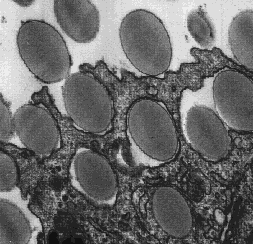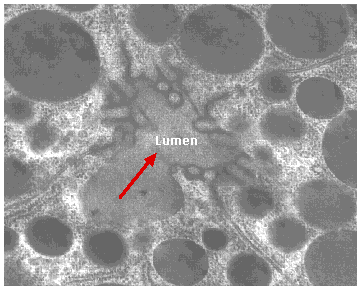Exocytosis
 Exocytosis is the reverse of endocytosis.
Exocytosis is the reverse of endocytosis.
And that is just as well. In 30 minutes an active cell like a macrophage (right) can endocytose an amount of plasma membrane equal to its complete plasma membrane.
This electron micrograph (courtesy of Dr. Robert J. North) shows a guinea phagocyte ingesting polystyrene beads. Several beads are already enclosed in vacuoles while the others are in the process of being engulfed.
So the cell must have a mechanism to restore the normal amount of plasma membrane. Exocytosis is that mechanism.
The process.
Membrane-bound vesicles move to the cell surface where they fuse with the plasma membrane. This accomplishes three things:
- It restores the normal amount of plasma membrane.
- Any molecules dissolved in the fluid contents of these vesicles are discharged into the extracellular fluid - this is called secretion.
Example: the various components of the extracellular matrix are secreted by exocytosis.
- Any integral membrane proteins exposed to the interior surface of the vesicles will now be displayed at the cell surface because the vesicles turn inside out as they fuse with the plasma membrane. Thus exocytosis does not simply replace plasma membrane but ensures that the plasma membrane will display its characteristic cell-surface proteins. [see an example]

Exocytic vesicles are created from several sources:
- Some are simply endosomes traversing the cell.
- Others are pinched off from endosomes before they fuse with lysosomes. [see an example]
- Others bud off from the endoplasmic reticulum and Golgi apparatus taking their products to the surface of the cell.
Some cells specialize in secretion. In cells that secrete large amounts of protein, for example, the protein accumulates in specialized secretory granules formed by the Golgi apparatus. These move to the cell surface and discharge their contents to the outside.

Examples:
- Exocrine cells in the pancreas synthesize and secrete pancreatic digestive enzymes. This electron micrograph* shows four cells in the pancreas of a bat. The lumen where their apical surfaces meet leads eventually to the pancreatic duct draining into the small intestine. The spherical bodies (budded off from the Golgi apparatus) contain precursors of digestive enzymes. One is discharging its contents into the lumen by exocytosis (red arrow).
- the cells lining our intestine synthesize tiny droplets of fat and discharge them into the lacteals by exocytosis.
(* originally published in Fawcett, The Cell: Its Organelles and Inclusions, W. B. Saunders Co., 1966.)
30 May 1999
 Exocytosis is the reverse of endocytosis.
Exocytosis is the reverse of endocytosis.
